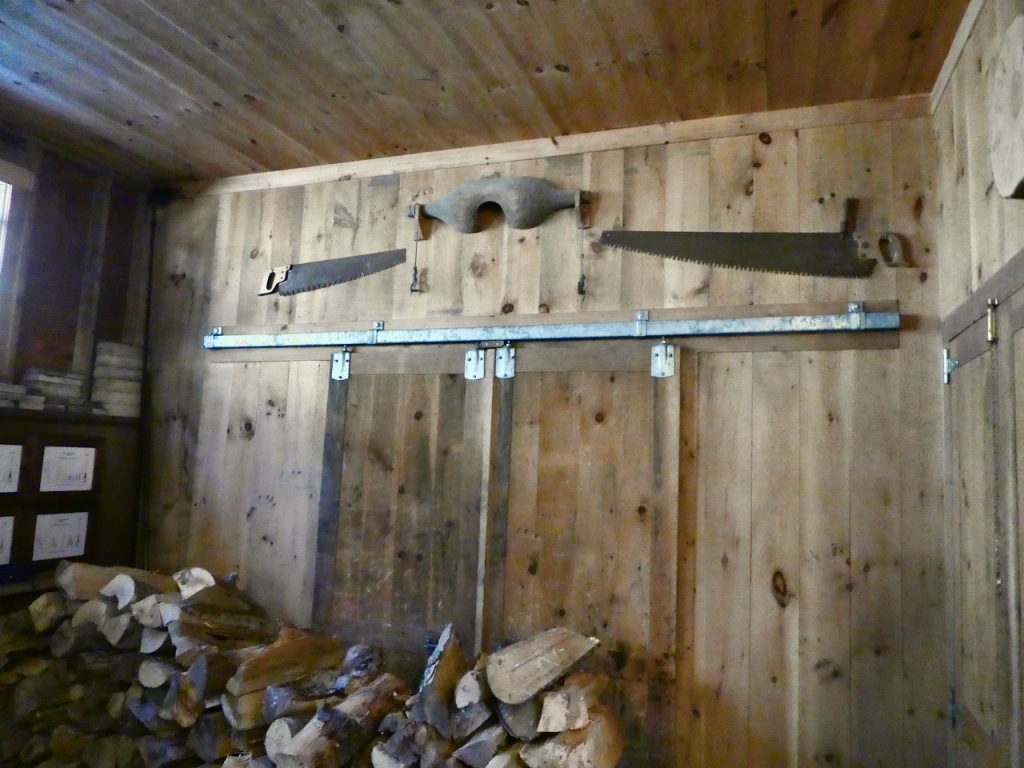Chief of Operations writes:
Visitors entering our evaporator room during boiling hours are immediately confronted by the roaring evaporator that commands their attention. As the initial shock of voraciously steaming pans subsides, the observant begin to notice a few other points of interest in this room.
High on the north wall over the woodshed doors hang remnants of my sugaring past. The two large hand saws on each side were used to cut the collection of hodgepodge, new and old beams that framed the original sugarhouse. When we joined the grid and built our present sugarhouse, these saws became obsolete and I was grateful for a place to display my old work mates where they wouldn’t be forgotten. The hewed log between these saws took me two days to fabricate with an inefficient, undersized chisel. I used it as a yoke to haul buckets of sap long distances in our earliest operation. It was heavy and a bit gawky, but far more comfortable than any other yoke I had tried, making the creation effort well worthwhile.
On the west wall are posted yearly charts of every day we have boiled since we started here in 1980. The first 40 are nicely framed. I promised myself years ago that when all those frames were filled I would sensibly retire from this crazy activity. Promises aren’t always kept, and any sugar maker will confirm how alarmingly seductive making maple syrup can be. With no room for more frames, charts of the remaining years are hung at one end on a homemade rolodex.
On the south wall clandestinely lives an X-rated description of guilt syrup.
The east wall is the business part of the boiling room where the finished syrup is filtered and canned. High on the left side of this wall, looming over the filter press, hangs a rather bizarre-looking geodesic structure. It sometimes snags the attention of observant eyes, and the inevitable question is “what the heck is that?”. Forming an answer doesn’t come easily, and I usually mumble something like “just an old pipe dream that maybe in my next lifetime I’ll actually get around to building”.
Back in the seventies the works of architect/inventor/futurist Buckminster Fuller were in the spotlight, and I was enamored with his geodesic domes. I became determined to build a house based on his ideas of triangulated framing, and created this wooden model as a first step.
To appreciate geodesic spheres a bit of geometry 101 is in order:
- A regular polygon is a polygon with all sides equal in length
- A platonic solid is a three-dimensional structure made solely from a regular polygon.
There are only five platonic solids. The pyramid, diamond, and icosahedron are made from triangles, the cube from squares, and the dodecahedron from pentagons.
Hexagons tesselate perfectly on a flat surface, but can’t fit together to form a structure in space. This inability to curve into a 3D structure remains true for any regular polygon having more than five sides.
The dodecahedron is an intriguing structure, but the icosahedron with more sides is more spherical, and is the basis for the geodesic domes popularized by Fuller. During the hippy era many homes were built using geodesic framing, though the rage was short-lived due to problems with sealing the multifaceted roof, and efficiently utilizing interior space with all those crazy wall angles.
And thus my model slowly morphed into a pipe dream. When we were living for years in a very cramped space, that large model was always right in my way wherever I placed it. It almost ended up in the dumpster numerous times. Thankfully when we built the new sugarhouse that high blank wall offered a place to permanently mount it. Whenever it’s brought to my attention by a starry-eyed visitor, I find myself enveloped in mixed feelings of inspiration and the heartbreak of unfulfilled dreams.
-LC






The desire to create pleasing living space is a desire familiar to many who think about or are contemplating building. Using sensible geometry meaning geometry not too difficult to realize in conventional building materials and construction does not always yield satisfying results. Geodesic dome construction is not conventional construction even though often realized in wood.
Geodesic dome construction has no beams or columns as they are defined by structural engineers. It has struts and end connections to other struts in the part of the building that is the dome geometry itself. Struts carry the load of the building axially along their lengths and the movement of each end connection is confined by its connection to neighboring struts. They are similar to trusses. This geodesic dome behavior Chief of Operations well knows and appreciates as both mathematically elegant and structurally pure. Elegant is a word used by many in reference to math and its equations and their ability to describe phenomena economically.
What a beautiful model!
LikeLike
Richard, Thank you for sharing your perspective as one trained in architectural design. I like the phrase “mathematically elegant and structurally pure”. AC
LikeLike
Hey, CHOPS, love that blog post. If haven’t every checked out “sacred geometry” do so, I think you’d like the topic.
Scott
LikeLike
Ah, elegant & pure & sacred best describe the fascinating side of mathematics. Platonic solids easily meet the high standards of these descriptors. I have always been intrigued by the icosahedron, and baffled by the dodecahedron. The way gawky pentagons that fail so miserably at tessellating, can fold into such a marvelous structure never ceases to amaze me! LC
LikeLike